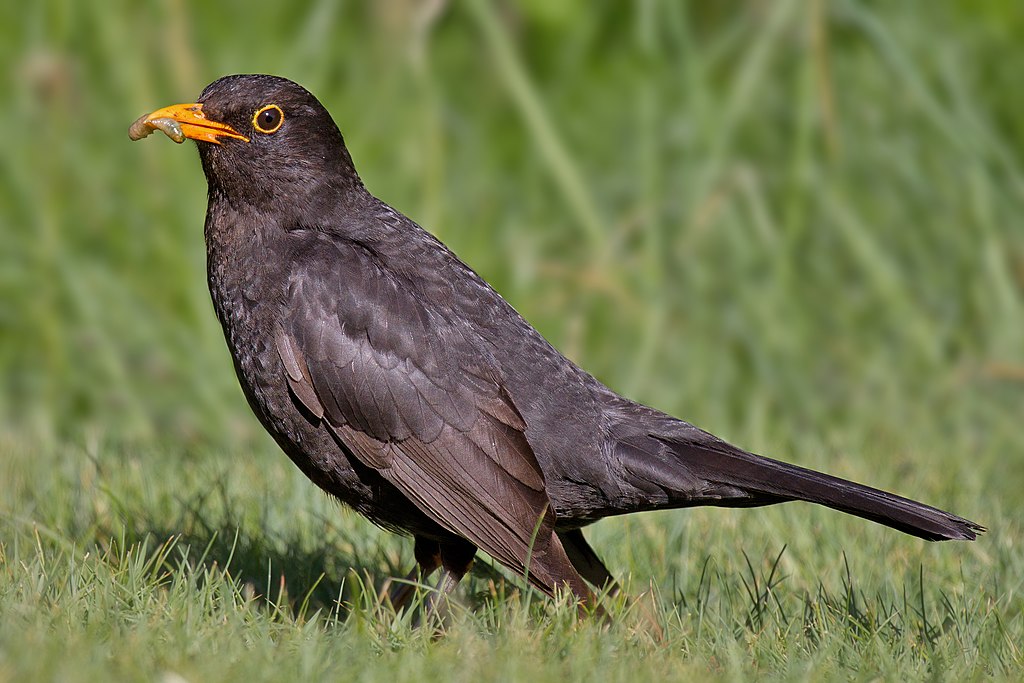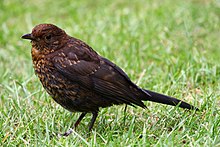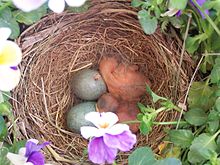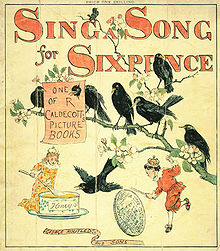The male of the nominate subspecies, which is found throughout most of Europe, is all black except for a yellow eye-ring and bill and has a rich, melodious song; the adult female and juvenile have mainly dark brown plumage. This species breeds in woods and gardens, building a neat, mud-lined, cup-shaped nest. It is omnivorous, eating a wide range of insects, earthworms, berries, and fruits.
Both sexes are territorial on the breeding grounds, with distinctive threat displays, but are more gregarious during migration and in wintering areas. Pairs stay in their territory throughout the year where the climate is sufficiently temperate. This common and conspicuous species has given rise to a number of literary and cultural references, frequently related to its song.

Taxonomy and systematics
The common blackbird was described by Linnaeus in the 10th edition of his Systema Naturae in 1758 as Turdus merula (characterised as T. ater, rostro palpebrisque fulvis).[4] The binomial name derives from two Latin words, turdus, "thrush", and merula, "blackbird", the latter giving rise to its French name, merle,[5] and its Scots name, merl.[6] About 65 species of medium to large thrushes are in the genus Turdus, characterised by rounded heads, longish, pointed wings, and usually melodious songs. The common blackbird seems to be closest in evolutionary terms to the island thrush (T. poliocephalus) of Southeast Asia and islands in the southwest Pacific, which probably diverged from T. merula stock fairly recently.[7]
It may not immediately be clear why the name "blackbird", first recorded in 1486, was applied to this species, but not to one of the various other common black English birds, such as the carrion crow, raven, rook, or jackdaw. However, in Old English, and in modern English up to about the 18th century, "bird" was used only for smaller or young birds, and larger ones such as crows were called "fowl". At that time, the blackbird was therefore the only widespread and conspicuous "black bird" in the British Isles.[8] Until about the 17th century, another name for the species was ouzel, ousel or wosel (from Old English osle, cf. German Amsel). Another variant occurs in Act 3 of Shakespeare's A Midsummer Night's Dream, where Bottom refers to "The Woosell cocke, so blacke of hew, With Orenge-tawny bill". The ouzel usage survived later in poetry, and still occurs as the name of the closely related ring ouzel (Turdus torquatus), and in water ouzel, an alternative name for the unrelated but superficially similar white-throated dipper (Cinclus cinclus).[9]
Juvenile T. m. merula in England
A leucistic adult male in England with much white in the plumage
T. m. cabrerae on Gran Canaria, Canary Islands, Spain
The icterid family of the New World is sometimes called the blackbird family because of some species' superficial resemblance to the common blackbird and other Old World thrushes, but they are not evolutionarily close, being related to the New World warblers and tanagers.[11] The term is often limited to smaller species with mostly or entirely black plumage, at least in the breeding male, notably the cowbirds,[12] the grackles,[13] and for around 20 species with "blackbird" in the name, such as the red-winged blackbird and the melodious blackbird.[11]
Subspecies
As would be expected for a widespread passerine bird species, several geographical subspecies are recognised. The treatment of subspecies in this article follows Clement et al. (2000).[7]
Near adult of nominate subspecies still showing some brown in the wings
Female of subspecies merula
- T. m. merula, the nominate subspecies, breeds commonly throughout much of Europe from Iceland, the Faroes and the British Isles east to the Ural Mountains and north to about 70 N, where it is fairly scarce. A small population breeds in the Nile Valley. Birds from the north of the range winter throughout Europe and around the Mediterranean including Cyprus and North Africa. The introduced birds in Australia and New Zealand are of the nominate race.[7]
- T. m. azorensis is a small race which breeds in the Azores. The male is darker and glossier than merula.[14]
- T. m. cabrerae, named for Ángel Cabrera, Spanish zoologist, resembles azorensis and breeds in Madeira and the western Canary Islands.[14]
- T. m. mauretanicus, another small dark species with a glossy black male plumage, breeds in central and northern Morocco, coastal Algeria and northern Tunisia.[14]
First-summer male, probably subspecies aterrimus
- T m. aterrimus breeds in Hungary, south and east to southern Greece, Crete northern Turkey and northern Iran. It winters in southern Turkey, northern Egypt, Iraq and southern Iran. It is smaller than merula with a duller male and paler female plumage.[14]
- T. m. syriacus breeds on the Mediterranean coast of southern Turkey south to Jordan, Israel and the northern Sinai. It is mostly resident, but part of the population moves south west or west to winter in the Jordan Valley and in the Nile Delta of northern Egypt south to about Cairo. Both sexes of this subspecies are darker and greyer than the equivalent merula plumages.[7]
- T. m. intermedius is an Asiatic race breeding from Central Russia to Tajikistan, western and north east Afghanistan, and eastern China. Many birds are resident but some are altitudinal migrants and occur in southern Afghanistan and southern Iraq in winter.[7] This is a large subspecies, with a sooty-black male and a blackish-brown female.[15]
Similar species
In Europe, the common blackbird can be confused with the paler-winged first-winter ring ouzel (Turdus torquatus) or the superficially similar European starling (Sturnus vulgaris).[17] A number of similar Turdus thrushes exist far outside the range of the common blackbird, for example the South American Chiguanco thrush (Turdus chiguanco).[18] The Indian blackbird, the Tibetan blackbird, and the Chinese blackbird were formerly considered subspecies.[19]Description
The common blackbird of the nominate subspecies T. m. merula is 23.5 to 29 centimetres (9.25 to 11.4 in) in length, has a long tail, and weighs 80–125 grams (2.8 to 4.4 oz). The adult male has glossy black plumage, blackish-brown legs, a yellow eye-ring and an orange-yellow bill. The bill darkens somewhat in winter.[17] The adult female is sooty-brown with a dull yellowish-brownish bill, a brownish-white throat and some weak mottling on the breast. The juvenile is similar to the female, but has pale spots on the upperparts, and the very young juvenile also has a speckled breast. Young birds vary in the shade of brown, with darker birds presumably males.[17] The first year male resembles the adult male, but has a dark bill and weaker eye ring, and its folded wing is brown, rather than black like the body plumage.[7]Distribution and habitat
The common blackbird breeds in temperate Eurasia, North Africa, the Canary Islands, and South Asia. It has been introduced to Australia and New Zealand.[7] Populations are sedentary in the south and west of the range, although northern birds migrate south as far as northern Africa and tropical Asia in winter.[7] Urban males are more likely to overwinter in cooler climes than rural males, an adaptation made feasible by the warmer microclimate and relatively abundant food that allow the birds to establish territories and start reproducing earlier in the year.[20]Common over most of its range in woodland, the common blackbird has a preference for deciduous trees with dense undergrowth. However, gardens provide the best breeding habitat with up to 7.3 pairs per hectare (nearly three pairs per acre), with woodland typically holding about a tenth of that density, and open and very built-up habitats even less.[21] They are often replaced by the related ring ouzel in areas of higher altitude.[22]
The common blackbird occurs up to 1000 metres (3300 ft) in Europe, 2300 metres (7590 ft) in North Africa, and at 900–1820 metres (3000–6000 ft) in peninsular India and Sri Lanka, but the large Himalayan subspecies range much higher, with T. m. maximus breeding at 3200–4800 metres (10560–16000 ft) and remaining above 2100 metres (6930 ft) even in winter.[7]
This widespread species has occurred as a vagrant in many locations in Eurasia outside its normal range, but records from North America are normally considered to involve escapees, including, for example, the 1971 bird in Quebec.[23] However, a 1994 record from Bonavista, Newfoundland, has been accepted as a genuine wild bird,[7] and the species is therefore on the North American list.[24]
Behaviour and ecology
Eggs in a nest
Two chicks in their first hours as another egg begins to hatch
Two chicks in a nest
The bill's appearance is important in the interactions of the common blackbird. The territory-holding male responds more aggressively towards models with orange bills than to those with yellow bills, and reacts least to the brown bill colour typical of the first-year male. The female is, however, relatively indifferent to bill colour, but responds instead to shinier bills.[25]
As long as winter food is available, both the male and female will remain in the territory throughout the year, although occupying different areas. Migrants are more gregarious, travelling in small flocks and feeding in loose groups in the wintering grounds. The flight of migrating birds comprises bursts of rapid wing beats interspersed with level or diving movement, and differs from both the normal fast agile flight of this species and the more dipping action of larger thrushes.[14]
Breeding
Eggs, Collection Museum Wiesbaden
Nominate T. merula may commence breeding in March, but eastern and Indian races are a month or more later, and the introduced New Zealand birds start nesting in August.[7][22] The breeding pair prospect for a suitable nest site in a creeper or bush, favouring evergreen or thorny species such as ivy, holly, hawthorn, honeysuckle or pyracantha.[28] Sometimes the birds will nest in sheds or outbuildings where a ledge or cavity is used. The cup-shaped nest is made with grasses, leaves and other vegetation, bound together with mud. It is built by the female alone. She lays three to five (usually four) bluish-green eggs marked with reddish-brown blotches,[21] heaviest at the larger end;[22] the eggs of nominate T. merula are 2.9×2.1 centimetres (1.14×0.93 in) in size and weigh 7.2 grammes (0.25 oz), of which 6% is shell.[29] Eggs of birds of the southern Indian races are paler than those from the northern subcontinent and Europe.[7] The female incubates for 12–14 days before the altricial chicks are hatched naked and blind. Fledging takes another 10–19 (average 13.6) days, with both parents feeding the young and removing faecal sacs.[14] The nest is often ill-concealed compared with those of other species, and many breeding attempts fail due to predation.[30] The young are fed by the parents for up to three weeks after leaving the nest, and will follow the adults begging for food. If the female starts another nest, the male alone will feed the fledged young.[21] Second broods are common, with the female reusing the same nest if the brood was successful, and three broods may be raised in the south of the common blackbird's range.[7]
A common blackbird has an average life expectancy of 2.4 years,[31] and, based on data from bird ringing, the oldest recorded age is 21 years and 10 months.[32]
Songs and calls
 |
At least two subspecies, T. m. merula and T. m. nigropileus, will mimic other species of birds, cats, humans or alarms, but this is usually quiet and hard to detect.
Feeding
Adult male feeding on berries in Lausanne, Switzerland
Natural threats
A male attempting to distract a male kestrel close to its nest
This species is occasionally a host of parasitic cuckoos, such as the common cuckoo (Cuculus canorus), but this is minimal because the common blackbird recognizes the adult of the parasitic species and its non-mimetic eggs.[37] In the UK, only three nests of 59,770 examined (0.005%) contained cuckoo eggs.[38] The introduced merula blackbird in New Zealand, where the cuckoo does not occur, has, over the past 130 years, lost the ability to recognize the adult common cuckoo but still rejects non-mimetic eggs.[39]
As with other passerine birds, parasites are common. 88% of common blackbirds were found to have intestinal parasites, most frequently Isospora and Capillaria species.[40] and more than 80% had haematozoan parasites (Leucocytozoon, Plasmodium, Haemoproteus and Trypanosoma species).[41]
Common blackbirds spend much of their time looking for food on the ground where they can become infested with ticks, which are external parasites that most commonly attach to the head of a blackbird.[42] In France, 74% of rural blackbirds were found to be infested with Ixodes ticks, whereas, only 2% of blackbirds living in urban habitats were infested.[42] This is partly because it is more difficult for ticks to find another host on lawns and gardens in urban areas than in uncultivated rural areas, and partly because ticks are likely to be commoner in rural areas, where a variety of tick hosts, such as foxes, deer and boar, are more numerous.[42] Although ixodid ticks can transmit pathogenic viruses and bacteria, and are known to transmit Borrelia bacteria to birds,[43] there is no evidence that this affects the fitness of blackbirds except when they are exhausted and run down after migration.[42]
The common blackbird is one of a number of species which has unihemispheric slow-wave sleep. One hemisphere of the brain is effectively asleep, while a low-voltage EEG, characteristic of wakefulness, is present in the other. The benefit of this is that the bird can rest in areas of high predation or during long migratory flights, but still retain a degree of alertness.[44]
Status and conservation
The common blackbird has an extensive range, estimated at 10 million square kilometres (3.8 million square miles), and a large population, including an estimated 79 to 160 million individuals in Europe alone. The species is not believed to approach the thresholds for the population decline criterion of the IUCN Red List (i.e., declining more than 30% in ten years or three generations), and is therefore evaluated as Least Concern.[1] In the western Palaearctic, populations are generally stable or increasing,[14] but there have been local declines, especially on farmland, which may be due to agricultural policies that encouraged farmers to remove hedgerows (which provide nesting places), and to drain damp grassland and increase the use of pesticides, both of which could have reduced the availability of invertebrate food.[35]The common blackbird was introduced to Australia by a bird dealer visiting Melbourne in early 1857,[45] and its range has expanded from its initial foothold in Melbourne and Adelaide to include all of south-eastern Australia, including Tasmania and the Bass Strait islands.[46] The introduced population in Australia is considered a pest because it damages a variety of soft fruits in orchards, parks and gardens including berries, cherries, stone fruit and grapes.[45] It is thought to spread weeds, such as blackberry, and may compete with native birds for food and nesting sites.[45][47]
The introduced common blackbird is, together with the native silvereye (Zosterops lateralis), the most widely distributed avian seed disperser in New Zealand. Introduced there along with the song thrush (Turdus philomelos) in 1862, it has spread throughout the country up to an elevation of 1,500 metres (4,921 ft), as well as outlying islands such as the Campbell and Kermadecs.[48] It eats a wide range of native and exotic fruit, and makes a major contribution to the development of communities of naturalised woody weeds. These communities provide fruit more suited to non-endemic native birds and naturalised birds, than to endemic birds.[49]
In culture
Sing a Song for Sixpence cover illustration
Sing a song of sixpence,The common blackbird's melodious, distinctive song is mentioned in the poem Adlestrop by Edward Thomas;
A pocket full of rye;
Four and twenty blackbirds baked in a pie!
When the pie was opened the birds began to sing,
Oh wasn't that a dainty dish to set before the king?[52]
And for that minute a blackbird sangIn the English Christmas carol The Twelve Days of Christmas, the line commonly sung today as "four calling birds" is believed to have originally been written in the 18th century as "four colly birds", an archaism meaning "black as coal" that was a popular English nickname for the common blackbird.[54]
Close by, and round him, mistier,
Farther and farther, all the birds
Of Oxfordshire and Gloucestershire.[53]
The common blackbird, unlike many black creatures, is not normally seen as a symbol of bad luck,[51] but R. S. Thomas wrote that there is "a suggestion of dark Places about it",[55] and it symbolised resignation in the 17th century tragic play The Duchess of Malfi;[56] an alternate connotation is vigilance, the bird's clear cry warning of danger.[56]
The common blackbird is the national bird of Sweden,[57] which has a breeding population of 1–2 million pairs,[14] and was featured on a 30 öre Christmas postage stamp in 1970;[58] it has also featured on a number of other stamps issued by European and Asian countries, including a 1966 4d British stamp and an 1998 Irish 30p stamp.[59] This bird—arguably—also gives rise to the Serbian name for Kosovo, which is the possessive adjectival form of Serbian kos ("blackbird") as in Kosovo Polje ("Blackbird Field").














No comments:
Post a Comment
Note: Only a member of this blog may post a comment.